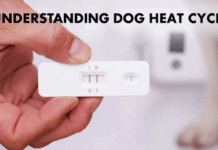Last Updated on April 29, 2023 by Dogs Vets
Best Calming Beds to Help If Your Dog Has Separation Anxiety.
Separation anxiety is a common problem for many dogs, especially if they are left alone for long periods of time or have experienced trauma in the past.
It can cause them to exhibit behaviors such as barking, chewing, pacing, whining, or even trying to escape. These behaviors can be stressful for both the dog and the owner, and can damage the bond between them.
One way to help your dog cope with separation anxiety is to provide them with a comfortable and soothing place to rest and relax.
A calming bed is a type of dog bed that is designed to provide extra support and warmth for your dog, and to create a sense of security and safety.
A calming bed can help your dog feel more calm and relaxed when you are away, and reduce their anxiety levels.
But not all calming beds are created equal. Some may be too small, too thin, too hard, or too flimsy for your dog’s needs. That’s why you need to find the best calming bed for your dog, one that suits their size, shape, personality, and preferences.
The best calming bed should have the following features:
- A soft and cozy material that is breathable and durable.
- A raised rim that creates a sense of enclosure and protection.
- A deep and spacious center that allows your dog to curl up or stretch out.
- A non-slip bottom that prevents the bed from sliding or moving.
- A machine-washable cover that is easy to clean and maintain
If you are looking for the best calming bed for your dog, you may want to check out the Calm Pooch Bed.
This bed has all the features mentioned above, and more. It is made of high-quality faux fur that mimics the feeling of a mother’s fur, and has a memory foam base that adapts to your dog’s body shape and weight.
It also comes in various sizes and colors, so you can choose the one that fits your dog and your home decor.
The Calm Pooch Bed has received many positive reviews from satisfied customers who have seen improvements in their dogs’ behavior and mood after using it.
Many dogs have become more calm, relaxed, happy, and confident after sleeping on this bed. Some have even stopped barking or chewing when left alone.
If you want to help your dog overcome their separation anxiety, you may want to give the Calm Pooch Bed a try. It could be the best calming bed for your dog, and the best gift for yourself.
Separation anxiety
Separation anxiety occurs in dogs that have a tough time being left alone. It can lead to destructive behavior to overcome their stress, and they might even become aggressive.
It is so common for dogs with this condition to have an accident inside the house that it is sometimes called “submissive urination.”
Ways to Know If Dogs Have Separation Anxiety
- They drool, shake, and pant.
- Their ears may go back.
- They may vomit as a result of their stress and anxiety.
- They try to escape through windows or other small spaces.
If you observe any of these activities in your pet’s behavior, take it to a veterinarian immediately.
You can also take essential steps like buying a Calming Dog Bed to make your pet feel less anxious and more coddled.
But before proceeding, read on to know the basics of choosing the right bed for your dog.
Ways to Know If Dogs Have Separation Anxiety
- They drool, shake, and pant.
- Their ears may go back.
- They may vomit as a result of their stress and anxiety.
- They try to escape through windows or other small spaces.
If you observe any of these activities in your pet’s behavior, take it to a veterinarian immediately. You can also take essential steps like buying a Calming Dog Bed to make your pet feel less anxious and more coddled.
But before proceeding, read on to know the basics of choosing the right bed for your dog.
What are Calming Beds for Dogs?
A calming bed is a special dog bed designed to provide comfort and support for your pet when feeling anxious or stressed.
It has a very soft, comfy interior, but it also emits pheromones that help calm your pet and reduce their anxiety levels. The beds are available in varied colors and designs with removable covers to suit any taste or preference.
Will Calming Beds for Dogs Work for Your Dog?
If your dog has separation anxiety, the answer is “yes,” because calming beds are designed with this condition in mind. They provide a safe space where your pet will be able to chill out while you’re gone. So yes, calming dog beds work well with any dog breed having separation anxiety.
What Calming Beds for Dogs Should You Buy?
Choosing the right type of calming bed is very important if your dog has separation anxiety or any other condition that affects its mood and behavior.
Here are some things to keep in mind when you are looking at different beds on the market.
- Your dog’s weight.
- The type of material used in the bed and ensure it is machine washable.
- Choose the right size with circular ridges.
- The bed’s sturdiness and construction quality.
It’s a good idea to look at a calming dog bed because this will make finding a product that meets your dog’s needs easier.
Some beds have anti-skid pads that will keep the bed in its place even when your pet moves around a lot. You can also buy these comfortable beds for pets having joint issues.
Separation anxiety occurs in dogs that have a tough time being left alone. It can lead to destructive behavior to overcome their stress, and they might even become aggressive.
It is so common for dogs with this condition to have an accident inside the house that it is sometimes called “submissive urination.”
What are Calming Beds for Dogs?
A calming bed is a special dog bed designed to provide comfort and support for your pet when feeling anxious or stressed.
It has a very soft, comfy interior, but it also emits pheromones that help calm your pet and reduce their anxiety levels. The beds are available in varied colors and designs with removable covers to suit any taste or preference.
Here are 5 simple ways calming beds help with your dog’s comfort.
1. Calming Dog Beds Offer a Sense of Security
Dogs with separation anxiety can feel abandoned and helpless, so they tend to do everything they can to try and regain control over their environment.
Their resting place is an important part of this picture. A Calming Dog Bed provides them with a safe spot where they can rest undisturbed, and it lets them know that you’re still around.
2. Their Breathing Rate Stays in Control
Calming beds for dogs often feature a raised side, which helps the dog keep an eye on its environment while still feeling secure because of the bed’s high walls.
The elevated position also has another benefit: it mimics how their mothers would hold them as pups. This helps the dog calm down and breathe at a slower pace.
3. A Calming Bed for Dogs is Cheap Insurance
A high percentage of dogs with separation anxiety find ways to escape, so accidents are common.
If your pet urinates on the floor or chews up your valuable furniture while you are gone, getting a calming bed will be cheaper than any professional treatment for this condition. It works just as well as a dog crate for this purpose.
4. Calming Bed Helps Dogs Heal from Stress
In addition to a sense of security, a calming bed also has a soothing effect on most canines. Just as you might feel better with an extra blanket when you have a cold, dogs are comforted by their bedding.
A good way to work on the problem of your dog’s separation anxiety is to make sure it gets plenty of rest while you are gone.
5. Dogs Calm Down Faster in Their Calming Beds
Dogs with separation anxiety may take a long time to calm down, especially if they are very stressed when you come home.
A calming bed can shorten the process of getting your pet back to normal because it offers a place where it is more likely to feel comfortable, secure, and relaxed.
Will Calming Beds for Dogs Work for Your Dog?
If your dog has separation anxiety, the answer is “yes,” because calming beds are designed with this condition in mind. They provide a safe space where your pet will be able to chill out while you’re gone. So yes, calming dog beds work well with any dog breed having separation anxiety.
What Calming Beds for Dogs Should You Buy?
Choosing the right type of calming bed is very important if your dog has separation anxiety or any other condition that affects its mood and behavior.
Here are some things to keep in mind when you are looking at different beds on the market.
- Your dog’s weight.
- The type of material used in the bed and ensure it is machine washable.
- Choose the right size with circular ridges.
- The bed’s sturdiness and construction quality.
It’s a good idea to look at a calming dog bed because this will make finding a product that meets your dog’s needs easier.
Some beds have anti-skid pads that will keep the bed in its place even when your pet moves around a lot. You can also buy these comfortable beds for pets having joint issues.
Conclusion
We hope you enjoyed this article… What are your thoughts on Best Calming Bed Help If Your Dog Has Separation Anxiety?
Please feel free to share with us in the comments section below.
Fact Check
We strive to provide the latest valuable information for pet lovers with accuracy and fairness. If you would like to add to this post or advertise with us, don’t hesitate to reach us. If you see something that doesn’t look right, contact us!



















